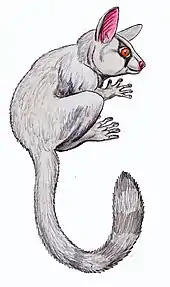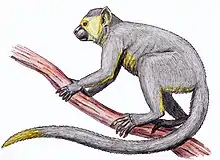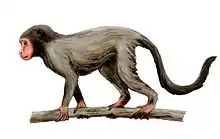| Anadoluvius Temporal range: 8.7 Miocene | |
|---|---|
 | |
| Partial female face and cranium. | |
| Scientific classification | |
| Domain: | Eukaryota |
| Kingdom: | Animalia |
| Phylum: | Chordata |
| Class: | Mammalia |
| Order: | Primates |
| Suborder: | Haplorhini |
| Infraorder: | Simiiformes |
| Family: | Hominidae |
| Subfamily: | Homininae |
| Genus: | †Anadoluvius Sevim-Erol et al. 2023 |
| Type species | |
| †Anadoluvius turkae (Sevim-Erol et al. 2023) | |
| Synonyms | |
|
†Ouranopithecus turkae Güleç, Sevim, Pehlevan & Kaya, 2007 | |
Anadoluvius is an extinct species of Homininae that was discovered at the site of Çorakyerler, central Anatolia during the Miocene.[1] It comprises a single species, A. turkae. The genus may shed light on the origin of Hominini on the cusp of Europe and Africa.[2] [3] Currently, the creation of Anadoluvius to replace Ouranopithecus turkae is not yet fully accepted by the paleontological community.
Description
The genus is known from Çorakyerler, and was excavated in 2015 and originally[4] named Ouranopithecus turkae.[5] The ape discovered was around 50-60 kg, the size of a large chimpanzee.[6] Sevim-Erol et al. (2023) described Anadoluvius turkae, a new name, based on the mostly complete male palate preserving LI1-M3 and RC-M2 and a series of paratypes. The holotype is CO-205, and paratypes are CO-300 (right M2), CO-305 (male mandibular fragment), CO-710 (female mandibular fragment), CO-2100 (right I1), and CO-2800 (female partial cranium). The genus name derives from Anadolu, a Turkish denomination that describes something that is Anatolian.[2]
Cranium
The cranium recovered was assigned a female, and it was discovered in several pieces and restored to form a face with dental remains and a frontal. The frontal is missing parts of the temporal fossa and the squama positioned near the bregma. These characters are distinguishing from Ouranopithecus, which does not preserve the squama. The orientation and shape of the premaxilla is much alike Ouranopithecus, however, which suggests that these taxa overlap in their anatomy. Compared to extant hominids and australopiths, the premaxilla is short and is most alike to gorillas and dryopiths. The alveolar portion is reduced, but the nasal area is expanded to overlap the maxillary palatine process. The incisor alveoli sits along the mesial transverse plane. The frontal differs from Ouranopithecus greatly in the biconvex squama, which is smooth, and the superior orbital margins, which is flat and sharp.[2]
Mandible
The mandibular remains of this species, Nikiti 1, and Graecopithecus are all distinguished from themselves and Ouranopithecus. This suggests that the samples are very diverse in morphology. Like the other two, the mandible is narrowed, unlike Ouranopithecus. In terms of dental robusticity, Anadoluvius is like Ouranopithecus in the premolar level, but the molar level level much more robust to match any sample. The corpus differs in robusticity in different ratios. It differs from Graecopithecus in all ratios, NKT 21 in many values, and falls beyond Ouranopithecus in molar corpus breadth.[2]
Teeth
The distal roots of the P3 to M1 are fused singular with two canals. The enamel is thick and suggests that the thickness of the M2 was variable in hominids starting from the Miocene. It falls within the upper range limit of Afropithecus. The M2 and M3 RET is above-range for all extant hominids and is alike to Australopithecus. Canine size is alike to the latter, and signs of reduction in earlier samples such as this one suggest an early form of the African hominin condition.[2]
Classification
Sevim-Erol et al. (2023) faced the problem of coding a phylogenetics character set using the features of Sahelanthropus outlined in literature versus personal anecdote, and they used synapomorphies to code the remaining tree. It and Ouranopithecus are united in a clade either sister to the dryopiths or in an unresolved polychotomy with dryopiths/crown hominines, with Nakalipithecus as a possible ancestor of Ouranopithecus. It, Graecopithecus, and Ouranopithecus host derived characters in the craniodental-mandibular remains. They find:[2]
| |||||||||||||||||||||||||||||||||||||
| |||||||||||||||||||||||||||||||||||||
As it stands, the creation of the new genus for O. turkae is not yet fully accepted by the paleontological community. This clade shares traits with European middle and late Miocene hominids, which is distinguishing from contemporaneous pongines. It is not known if the bulky-toothed Anatolian samples are related to the thinner-toothed dryopith samples. It is determined most likely that the dryopiths represent a widespread European line of hominines of which the Anadoluvius was related.[2] Anadoluvius has early hominin morphology that probably radiated in western/central[6] Europe, possibly related to Gorillini or African migrations. However, evidence of other hominine lineages 13-10 mya is nonexistent and phylogenetically unsupported.[2]
Paleoecology
The locality is a dried, open forest, and Andaluvius probably spent much time on the ground. The jaws and teeth support a diet of roots, rhizomes, and other hard and tough items.[5] The environment is characterized by typical African grassland and dry forests, such as giraffes, warthogs, rhinoceros, antelopes, zebras, elephants, porcupines, hyenas, and big cats.[6]
References
- ↑ Knapton, Sarah (September 3, 2023). "Discovery of 8.7m-year-old ape rewrites story of humanity" – via www.telegraph.co.uk.
- 1 2 3 4 5 6 7 8 Sevim-Erol, Ayla; Begun, D. R.; Sözer, Ç Sönmez; Mayda, S.; van den Hoek Ostende, L. W.; Martin, R. M. G.; Alçiçek, M. Cihat (2023-08-23). "A new ape from Türkiye and the radiation of late Miocene hominines". Communications Biology. 6 (1): 842. doi:10.1038/s42003-023-05210-5. ISSN 2399-3642. PMC 10447513. PMID 37612372.
- ↑ Toronto, University of (25 August 2023). "Discovery of 8.7-Million-Year-Old Fossil Ape Challenges Long-Accepted Ideas of Human Origins". SciTechDaily. Retrieved 20 September 2023.
- ↑ Kaya, Ferhat; Kaymakçi, Nuretdin; Bibi, Faysal; Eronen, Jussi T.; Pehlevan, Cesur; Erkman, Ahmet C.; Langereis, Cor G.; Fortelius, Mikael (2016-03-03). "Magnetostratigraphy and paleoecology of the hominid-bearing locality Çorakyerler, Tuglu Formation (Çankiri Basin, Central Anatolia)". Journal of Vertebrate Paleontology. 36 (2): e1071710. Bibcode:2016JVPal..36E1710K. doi:10.1080/02724634.2015.1071710. ISSN 0272-4634. S2CID 130168784.
- 1 2 Güleç; Sevim; Pehlevan; Kaya (2007). "A new great ape from the late Miocene of Turkey". Anthropological Science. 115 (2): 153–158. doi:10.1537/ase.070501.
- 1 2 3 Toronto, University of. "New ancient ape from Türkiye challenges the story of human origins". phys.org. Archived from the original on 2023-08-24. Retrieved 2023-08-24.



